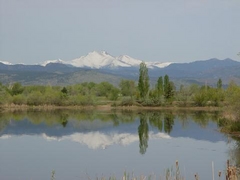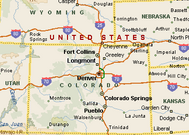On April 7, 1934, the country's first diesel streamliner called the Zephyr 9900 rolled out of the Budd plant in northern Philadelphia (the decaying grounds of this factory were mentioned in the Wall Street Journal just two weeks ago). Built out of stainless steel, it had a striking look with its shovel-nose form:
As a marketing ploy a month later in May, it made a highly advertised speed run from Denver to Chicago (1015 miles) in a record-smashing time of 13 hours, 5 minutes. Regular trains at the time would take 25 hours for the same route.
Six minute video of the Pioneer Denver to Chicago run, accompanied by Gershwin's Rhapsody in Blue:
This now-famous train even inspired a movie later that year, titled after its nickname, the "Silver Streak":
As more Zephyr's were produced, the 9900 was renamed "the Pioneer" (indicating it was the first) in 1936 and eventually placed into secondary routes. This takes us to Longmont in 1950 where the Pioneer was leased to the Colorado & Southern (C&S) Railway, running as a passenger train between Denver and Cheyenne. A great picture from the Denver Public Library collection captured the Pioneer at the Longmont station in February 1950:
 |
| Image from Denver Public Library |
On the morning of Saturday, April 29, 1950, Harold Anderson (age 49), a farmer from Johnstown, had just filled a tank on his truck with water from Johnson's Corner in Longmont and was heading eastbound for home. In the truck with him was his 4-year old daughter, Ingrid. As he crossed the north/south C&S tracks, his truck was slammed in the middle by the Pioneer Zepyhr as it was headed north for Cheyenne out of Longmont at 50 mph. Anderson and his daughter remained inside the vehicle as it was dragged north for 170 yards by the hobbled train. Miraculously, both survived. When interviewed as he was being moved to an ambulance, Anderson said that his truck windows were fogged up and that he neither saw or heard the train.
No passengers on the train were hurt and the engineer and conductor also survived the accident with no injuries. The fireman in the locomotive, however, didn't have such luck. The train's collision with the truck's water tank left veteran C&S Engineer Dan Grinstead of Denver (age 53), who was substituting as fireman, pinned inside the crushed cab with a broken pelvis and a fractured hip. He was given sedatives by a doctor while crews worked an hour and a half to cut him out of the twisted metal using blowtorches. Of course the Pioneer Zephyr was in no shape to continue to Cheyenne and it was pulled back to Longmont.
The next day, Ingrid was released from the Longmont Hospital with a few bruises and lacerations. Harold Anderson had some chest injuries but he was able to walk around and his condition was not thought to be serious. Grinstead was still in serious condition with his injuries and suffering from severe shock.
So where was this train-truck collision? The evening Times-Call on that Saturday described the location as "one half-mile east of Mumford's Corner, northeast of town."
Mumford's Corner is today the corner of Main Street (US 287) and Colorado Highway 66, named after a prominent Longmont family that lived in that area for decades. You're probably familiar with the train crossing just east of that intersection on 66, a little past Walmart.
The truck was dragged north almost two football fields long, along these tracks:
Mumford's Corner is long gone but the name is preserved in north Longmont:
This train wreck story is mentioned in Margaret Coel's fine 1991 book, Goin' Railroading. She wrote that Grinstead's injuries kept him hospitalized for months and that he was sadly forced to retire.
After the wreck, the Pioneer Zephyr was moved to Aurora, IL (1990's pop culture fans know Aurora as the home of Wayne's World) where it was repaired and put back into service. It was retired in 1960 and is now on display at the Museum of Science and Industry in Chicago:
Occasionally, some 35mm slides of the Longmont Zephyr accident appear on eBay. Out of respect to the seller, I won't post them here but this Google Images link (never guaranteed to work) may show some of them, with a red tow truck next to the wreckage.
And Ingrid Anderson? She'd be 68 today.

 One citizen's view of Longmont, Colorado, USA.
One citizen's view of Longmont, Colorado, USA.







































